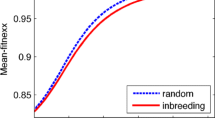Summary
General recursion formulae for the coefficient of inbreeding under a cyclical mating system were derived in which one male and one female are selected from each of the n families per generation (population size N = 2 n). Each male is given the family number of his sire in each generation, while his mate comes from another family, varying systematically in different generations. Males of the r-th family in generations 1, 2, 3,..., t′ = n−1 within each cycle mate with females from families r+1, r+2, r+3,..., r+t′ to produce generations 2, 3, 4,..., t′+1=1, respectively. The change in heterozygosity shows a cyclical pattern of rises and falls, repeating in cycles of n−1 generations. The rate of inbreeding oscillates between <-3% to >6% in different generations within each cycle, irrespective of the population size. The average rate of inbreeding per generation is approximately 1/[4 N-(Log2N+1)], which is the rate for the maximum avoidance of inbreeding. The average inbreeding effective population size is approximately 2 N−2.
Similar content being viewed by others
References
Abramowitz M, Stegun IA (eds) (1970) Handbook of mathematical functions. Doven Publications, New York, pp 827–869
Beilharz RG (1972) Studies in mouse breeding. 1. Description of mouse stocks in the School of Agriculture, University of Melbourne. Occ Pap, Section Anim Prod, Sch Agric Univ Melb, No 1
Beilharz RG (1982) The effect of inbreeding on reproduction in mice. Anim Prod 34:49–54
Cockerham CC (1970) Avoidance and rate of inbreeding. In: Kojima K (ed) Mathematical topics in population genetics. Springer, New York, pp 104–127
Davis PJ (1979) Circulant matrices. Wiley and Sons, New York
Farid A (1986) Inbreeding and litter size in sixteen control populations of mice of different origins. PhD Thesis, Dept Anim Sci, University of Alberta, Canada
Hill WG (1972) Estimation of genetic change. 1. General theory and design of control populations. Anim Breed Abstr 40:1–15
Karlin S (1968) Rates of approach to homozygosity for finite stochastic models with variable population size. Am Nat 102:443–455
Kimura M, Crow JF (1963) On the maximum avoidance of inbreeding. Genet Res 4:399–415
Malecot G (1969) The mathematics of heredity. Freeman & Co, San Francisco
Motro U, Thomson G (1982) On heterozygosity and the effective size of populations subject to size changes. Evolution 36:1059–1066
Robertson A (1964) The effect of non-random mating within inbred lines on the rate of inbreeding. Genet Res 5:164–167
Robinson P, Bray DF (1965) Expected effects on the inbreeding coefficients and rate of gene loss of four methods of reproducing finite diploid populations. Biometrics 21:447–458
Wright S (1921) Systems of mating. Genetics 6:111–178
Wright S (1965) The interpretation of population structure by F-statistics with special regard to systems of mating. Evolution 19:395–420
Author information
Authors and Affiliations
Additional information
Communicated by P.M.A.Tigerstedt
Rights and permissions
About this article
Cite this article
Farid, A., Makarechian, M. & Strobeck, C. Inbreeding under a cyclical mating system. Theoret. Appl. Genetics 73, 506–515 (1987). https://doi.org/10.1007/BF00289187
Received:
Accepted:
Issue Date:
DOI: https://doi.org/10.1007/BF00289187




